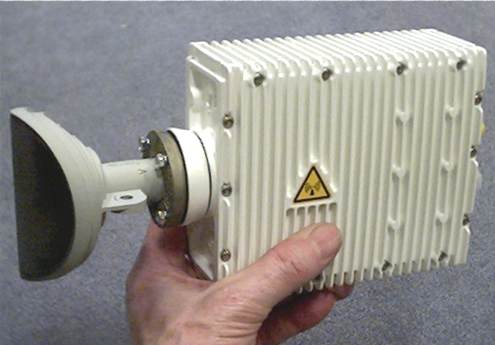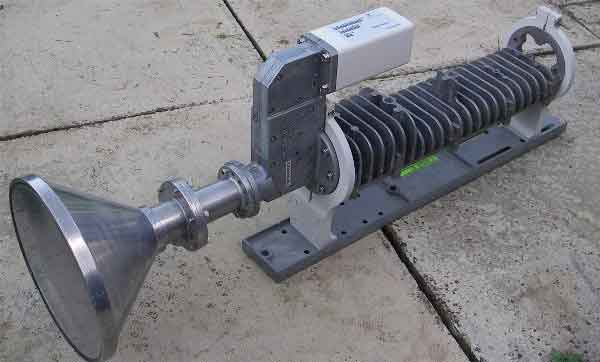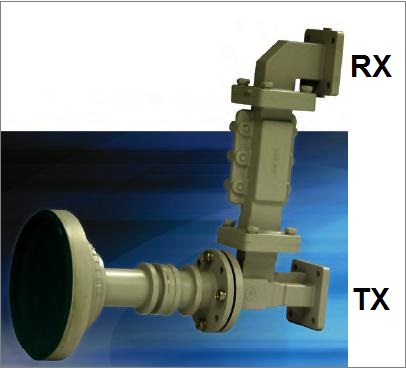The larger diameter Prodelin feed (silver coloured mode-matched horn and spacer tube) is associated with the Prodelin dish. The feed and dish work as a pair. The hidden three slots in the feed throat cancel out the cross-pol caused by the offset design and result in a feed/dish combination that is superior* to all other front-fed offset dishes. An offset dish with a subreflector achieves the same result using an extra mirror. Note that the 505 on the feed throat must always be oriented directly away from the feed arm.
Regarding the horn aperture diameter.
A small feed diameter results in a wide beam from the feed.
A large feed diameter results in a narrow beam from the feed.
Consider the view of the dish as seen from the feed and the angular width of the dish. In the case of reflectors with short f/d ratio, like 0.5 or 0.6, the feed is relatively close to the dish and the beam from the feed needs to be wide to illuminate the dish properly - so choose a smaller diameter feed. The opposite applies in the case of a long f/d dish, like 0.8, where the feed is relatively far away from the dish. The beam from the feed needs to be narrower to hit the dish and therefore the feed diameter must be larger.
Using the wrong feed will result in either low efficiency due to edge spill over and high interference sidelobes or low gain due to under-illumination of the outer regions of the dish. Think of a hand torch shone onto the dish at night. If the torch beam is too wide, lots of light misses the dish and lights up the surroundings (sidelobes) or if the torch beam is too narrow you only light up a small area in the middle of the dish (equivalent to having a very small diameter dish)
Regarding attaching devices at the flanges. On the Prodelin/HX type antenna the attachment flange for the TRIA is the 12 hole flange on the spacer tube. At this joint you may make the polarisation selection - horizontal or vertical, then turn the entire dish to set the exact polarisation adjustment angle, using the giant polarisation scale on the back.
The Hughes HX TRIA from Bentley Walker is illustrated. You can get an alternative, general purpose 3 and 5 watt
Ku band TRIA, with universal LNB, from us, suitable for LinkStar, iDirect, CDM570L modems etc.

The 5 watt version can be switched between co-pol and cross-pol operation. The Ku band TRIA comes with a set of adaptor rings to suit Prodelin, Andrew and Patriot dishes. It is a general purpose solution and costs more than separate OMT, LNB and BUC.
Regarding focussing. The distance from the feed horn to the dish must be correct. On an offset dish the apex of the parabola is approximately at the lower edge of the dish so the focal length is from the lower edge of the dish to the phase centre of the feed. The phase centre, or focal point, of the feed is the point where the rays all appear to come from.
In the case of scalar feeds (flat disk with rings and small round waveguide hole in the middle) the phase centre is at the waveguide hole aperture. In the case of long narrow tapered horns the phase centre is at the centre of the large feed horn window. In the case of intermediate taper angles, like these VSAT feeds, the phase centre may be anywhere on the centerline between the feed window and the throat. Only the manufacturer knows this and how the position varies with frequency, so you need to rely on the manufacturer to provide four assembly measurements (A,B,C,D) from the top and bottom of the dish to the top and bottom of the feed horn.
cylent - What happened to your second image in your first posting above ? Your image: https:// crypto.nsa.org/f-21/img_7680.jpg does not show due to the server IP address for crypto.nsa.org being unreachable from the public internet. Is this server inside your LAN firewall or something ? Please edit your posting; it is causing a long network timeout error when loading this page.
* except for the ERA diamond series of antennas, which use the same mode match feed.
Best regards, Eric.








